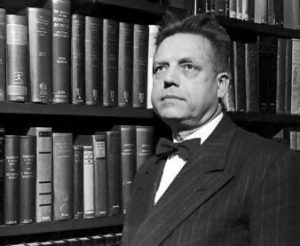
A few weekends ago, the Kinsey Institute for Research in Sex, Gender, and Reproduction hosted a day-long event to celebrate its seventieth anniversary. Founded by sexologist Alfred Kinsey in 1947, the institute is an independent research center located on the campus of Indiana University and continues to make insightful inroads into our understanding of human sexuality. The anniversary events provided a nice balance of exploring current research being conducted at the institute and pondering the organization’s history, particularly the legacy of its founder, author of the famed “Kinsey Reports”—officially titled Human Behavior in the Human Male (1948) and Human Behavior in the Human Female (1953)—which shocked the mid-twentieth-century United States by offering a detailed study of what white Americans were actually doing sexually.
While I am not affiliated with the Kinsey Institute, I have been thinking a lot about Alfred Kinsey’s legacy lately. I am in the process of preparing a nomination to add the Alfred C. Kinsey House to the National Register of Historic Places. Part of this process involves articulating the historical significance of the person associated with the property—basically detailing the impact Kinsey had on U.S. history. In this nomination, I argue that the professor from Indiana University was significant both to the history of scientific thought and to social history.
Within the realm of science, I emphasize three of Kinsey’s contributions, which changed scientific understanding of sexuality:
- His team’s methodology, which went far beyond anything previously undertaken in the field of sexology, entailing live interviews with over 18,000 people from a range of backgrounds;
- His argument that what was then seen as sexually deviant behavior (same-sex sexual behavior, masturbation, premarital sexual activity, for example) was in fact commonactivities that represented simple variation within the human species;
- His introduction of the Kinsey Scale as a means of understanding human sexual identity on a spectrum, rather than the rigidly binary categories of homosexual and heterosexual.
In the realm of U.S. social history, I argue that Kinsey’s findings about sexual behavior in the United States created a national upheaval in moral systems that prompted some to call for a rethinking of sexual taboos—a precursor to the sexual revolution that would happen a decade after Kinsey’s study—and prompted others to perceive a crisis of moral values, which in turn triggered the retrenchment of conservative family ideals in the 1950s. For LGBTQ individuals, Kinsey’s findings offered evidence that sexual and gender variance were more common than previously thought, and this news inspired people to seek others who shared their desires. The result was both burgeoning LGBTQ subcultures and the start of a nascent political movement (known as the homophile movement).
This National Register nomination is currently under review, and some of its arguments for Kinsey’s significance may change during the revision period. For now, though, these thoughts are a quick summary of what I see as the nature of Alfred Kinsey’s legacy on American sexual thought.
